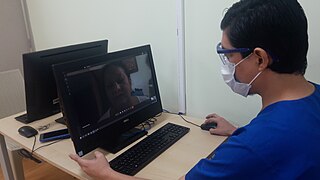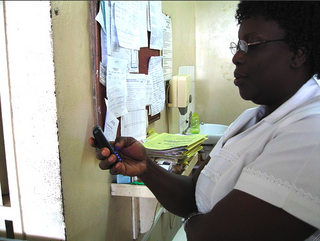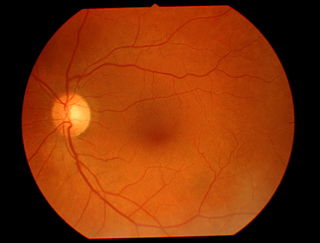Related Research Articles

Ambulatory care or outpatient care is medical care provided on an outpatient basis, including diagnosis, observation, consultation, treatment, intervention, and rehabilitation services. This care can include advanced medical technology and procedures even when provided outside of hospitals.

Telehealth is the distribution of health-related services and information via electronic information and telecommunication technologies. It allows long-distance patient and clinician contact, care, advice, reminders, education, intervention, monitoring, and remote admissions. Telemedicine is sometimes used as a synonym, or is used in a more limited sense to describe remote clinical services, such as diagnosis and monitoring. When rural settings, lack of transport, a lack of mobility, conditions due to outbreaks, epidemics or pandemics, decreased funding, or a lack of staff restrict access to care, telehealth may bridge the gap as well as provide distance-learning; meetings, supervision, and presentations between practitioners; online information and health data management and healthcare system integration. Telehealth could include two clinicians discussing a case over video conference; a robotic surgery occurring through remote access; physical therapy done via digital monitoring instruments, live feed and application combinations; tests being forwarded between facilities for interpretation by a higher specialist; home monitoring through continuous sending of patient health data; client to practitioner online conference; or even videophone interpretation during a consult.

Telerehabilitation (or e-rehabilitation is the delivery of rehabilitation services over telecommunication networks and the internet. Telerehabilitation allows patients to interact with providers remotely and can be used both to assess patients and to deliver therapy. Fields of medicine that utilize telerehabilitation include: physical therapy, occupational therapy, speech-language pathology, audiology, and psychology. Therapy sessions can be individual or community-based. Types of therapy available include motor training exercises, speech therapy, virtual reality, robotic therapy, goal setting, and group exercise.

The American Telemedicine Association (ATA), established in 1993, is a non-profit organization whose goal is to promote access to medical care for consumers and health professionals via telecommunications technology. Membership in the American Telemedicine Association is open to individuals, companies, and other healthcare and technology organizations.

mHealth is an abbreviation for mobile health, a term used for the practice of medicine and public health supported by mobile devices. The term is most commonly used in reference to using mobile communication devices, such as mobile phones, tablet computers and personal digital assistants (PDAs), and wearable devices such as smart watches, for health services, information, and data collection. The mHealth field has emerged as a sub-segment of eHealth, the use of information and communication technology (ICT), such as computers, mobile phones, communications satellite, patient monitors, etc., for health services and information. mHealth applications include the use of mobile devices in collecting community and clinical health data, delivery/sharing of healthcare information for practitioners, researchers and patients, real-time monitoring of patient vital signs, the direct provision of care as well as training and collaboration of health workers.
Teledermatology is a subspecialty in the medical field of dermatology and probably one of the most common applications of telemedicine and e-health. In teledermatology, telecommunication technologies are used to exchange medical information over a distance using audio, visual, and data communication. Applications comprise health care management such as diagnoses, consultation, and treatment as well as (continuous) education.
Connected health is a socio-technical model for healthcare management and delivery by using technology to provide healthcare services remotely. Connected health, also known as technology enabled care (TEC) aims to maximize healthcare resources and provide increased, flexible opportunities for consumers to engage with clinicians and better self-manage their care. It uses readily available consumer technologies to deliver patient care outside of the hospital or doctor's office. Connected health encompasses programs in telehealth, remote care and disease and lifestyle management, often leverages existing technologies such as connected devices using cellular networks and is associated with efforts to improve chronic care. However, there is an increasing blur between software capabilities and healthcare needs whereby technologists are now providing the solutions to support consumer wellness and provide the connectivity between patient data, information and decisions. This calls for new techniques to guide Connected Health solutions such as "design thinking" to support software developers in clearly identifying healthcare requirements, and extend and enrich traditional software requirements gathering techniques.

Health technology assessment (HTA) is a multidisciplinary process that uses systematic and explicit methods to evaluate the properties and effects of a health technology. Health technology is conceived as any intervention at any point in its lifecycle. HTA aim is to inform "decision-making in order to promote an equitable, efficient, and high-quality health system". It has other definitions including "a method of evidence synthesis that considers evidence regarding clinical effectiveness, safety, cost-effectiveness and, when broadly applied, includes social, ethical, and legal aspects of the use of health technologies. The precise balance of these inputs depends on the purpose of each individual HTA. A major use of HTAs is in informing reimbursement and coverage decisions by insurers and national health systems, in which case HTAs should include benefit-harm assessment and economic evaluation." And "a multidisciplinary process that summarises information about the medical, social, economic and ethical issues related to the use of a health technology in a systematic, transparent, unbiased, robust manner. Its aim is to inform the formulation of safe, effective, health policies that are patient focused and seek to achieve best value. Despite its policy goals, HTA must always be firmly rooted in research and the scientific method".
Patient participation is a trend that arose in answer to medical paternalism. Informed consent is a process where patients make decisions informed by the advice of medical professionals.
Medical technology assessment (MTA) is the objective evaluation of a medical technology regarding its safety and performance, its (future) impact on clinical and non-clinical patient outcomes as well as its interactive effects on economical, organizational, social, juridical and ethical aspects of healthcare. Medical technologies are assessed both in absolute terms and in comparison to other (combinations of) medical technologies, procedures, treatments or ‘doing-nothing’.
European Network for Health Technology Assessment (EUnetHTA) is a network, established to create an effective and sustainable structure for health technology assessment (HTA) across Europe that could develop and implement practical tools to provide reliable, timely, transparent and transferable information to contribute to HTAs in Member States.
The Institute for Quality and Efficiency in Healthcare (IQWiG) is a German agency responsible for assessing the quality and efficiency of medical treatments, including drugs, non-drug interventions, diagnostic and screening methods, and treatment and disease management. IQWiG also supplies health information to patients and the general public.

Remote patient monitoring (RPM) is a technology to enable monitoring of patients outside of conventional clinical settings, such as in the home or in a remote area, which may increase access to care and decrease healthcare delivery costs. RPM involves the constant remote care of patients by their physicians, often to track physical symptoms, chronic conditions, or post-hospitalization rehab.

Teleophthalmology is a branch of telemedicine that delivers eye care through digital medical equipment and telecommunications technology. Today, applications of teleophthalmology encompass access to eye specialists for patients in remote areas, ophthalmic disease screening, diagnosis and monitoring; as well as distant learning.
The Effect Model law states that a natural relationship exists for each individual between the frequency (observation) or the probability (prediction) of a morbid event without any treatment and the frequency or probability of the same event with a treatment . This relationship applies to a single individual, individuals within a population, or groups. This law enables the prediction of the (absolute) benefit of a treatment for a given patient. It has wide-reaching implications in R&D for new pharmaceutical products as well as personalized medicine. The law was serendipitously discovered in the 1990s by Jean-Pierre Boissel. While studying the effectiveness of class-I antiarrhythmic drugs in the prevention of death after myocardial infarction, he stumbled upon a situation which contradicts one of the basic premises of meta-analysis theory, i.e. that the heterogeneity test was significant at the same time for the assumption “the relative risk is a constant” and “ is a constant”.

Artificial intelligence in healthcare is an overarching term used to describe the use of machine-learning algorithms and software, or artificial intelligence (AI), to mimic human cognition in the analysis, presentation, and comprehension of complex medical and health care data, or to exceed human capabilities by providing new ways to diagnose, treat, or prevent disease. Specifically, AI is the ability of computer algorithms to approximate conclusions based solely on input data.
Guidances for statistics in regulatory affairs refers to specific documents or guidelines that provide instructions, recommendations, and standards pertaining to the application of statistical methodologies and practices within the regulatory framework of industries such as pharmaceuticals and medical devices. These guidances serve as a reference for statisticians, researchers, and professionals involved in designing, conducting, analyzing, and reporting studies and trials in compliance with regulatory requirements. These documents embody the prevailing perspectives of regulatory agencies on specific subjects. It is worth noting that in the United States, the term "Guidances" is used, while in Europe, the term "Guidelines" is employed.
The Swedish Agency for Health Technology Assessment and Assessment of Social Services previously the Swedish Council on Health Technology Assessment is an independent Swedish governmental agency tasked with assessing and evaluating methods in use in healthcare and social services. SBU is tasked with summarizing and communicating evidence and is a knowledge center for both healthcare and social services in Sweden. The agency performs review by systematically searching the literature, evaluating, assuring quality, and weighing together results. SBU does not carry out any original research beyond meta-analysis, systematic review or health technology assessment (HTA). It is one of the world's oldest HTA agencies that started conducting systematic reviews in 1987.
Noemi Lois is a Clinical Professor of Ophthalmology at Queen's University Belfast and an Honorary Consultant Ophthalmologist and Vitreoretinal Surgeon at the Belfast Health and Social Care Trust.
References
- ↑ Kidholm K, Ekeland AG, Jensen LK, Rasmussen J, Pedersen CD, Bowes A, Flottorp SA, Bech M. A model for assessment of telemedicine applications: MAST. Int J Technol Assess Health Care. 2012 Jan;28(1):44–51. PMID 22617736
- ↑ "The EQUATOR Network | Enhancing the QUAlity and Transparency of Health Research".
- ↑ Dyrvig AK, Kidholm K, Gerke O, Vondeling H. Checklists for external validity: a systematic review. J Eval Clin Pract. 2014 Dec;20(6):857-64
- ↑ Renewing Health
- ↑ United4Health
- ↑ Smartcare
- ↑ inCASA
- ↑ Patient@home
- ↑ Durand-Zaleski I, Zarca K, Charrier N, Treluyer L, Calinaud C. Deploying and assessing telemedicine in the Paris region: progress report. International Journal of Integrated Care (IJIC) . Nov2013, Vol. 13, p1-2. 2p.
- ↑ Campos C, Caudevilla E, Alesanco A, Lasierra N, Martinez O, Fernandez J, Garcia J. Setting up a telemedicine service for remote real-time video-EEG consultation in La Rioja (Spain). International Journal of Medical Informatics. Volume 81, Issue 6, June 2012, Pages 404–414.
- ↑ Sorknaes AD, Bech M, Madsen H, Titlestad IL, Hounsgaard L, Hansen-Nord M, Jest P, Olesen F, Lauridsen J, Østergaard B. The effect of real-time teleconsultations between hospital-based nurses and patients with severe COPD discharged after an exacerbation.J Telemed Telecare. 2013 Dec;19(8):466-74
- ↑ Torbjørnsen A, Jenum AK, Småstuen MC, Arsand E, Holmen H, Wahl AK, Ribu L. A Low-Intensity Mobile Health Intervention With and Without Health Counseling for Persons With Type 2 Diabetes, Part 1: Baseline and Short-Term Results From a Randomized Controlled Trial in the Norwegian Part of RENEWING HEALTH. JMIR Mhealth Uhealth. 2014 Dec 11;2(4):e52. doi: 10.2196/mhealth.3535.
- ↑ Tuula Karhula et al.: Telemonitoring and Mobile Phone-Based Health Coaching Among Finnish Diabetic and Heart Disease Patients: Randomized Controlled Trial. Journal of Medical Internet Research; 2015 Volume 17, Issue 6 e153.
- ↑ Rasmussen BS, Froekjaer J, Bjerregaard MR, Lauritsen J, Hangaard J, Henriksen CW, Halekoh U, Yderstraede KB. A Randomized Controlled Trial Comparing Telemedical and Standard Outpatient Monitoring of Diabetic Foot Ulcers. Diabetes Care. 2015 Jun 26.
- ↑ Rasmussen BS, Jensen LK, Froekjaer J, Kidholm K, Kensing F, Yderstraede KB. A qualitative study of the key factors in implementing telemedical monitoring of diabetic foot ulcer patients. Int J Med Inform. 2015 May 29
- ↑ Angel D, Bjerregaard J, O'Conner T, McGuinness W, Kröger K, Rasmussen BSR, Yderstraede KB. Chapter 3: The model for assessment of telemedicine (MAST) – evaluation of telemedical solutions. J Wound Care. 2015 May; 24 Suppl 5:S10-3.